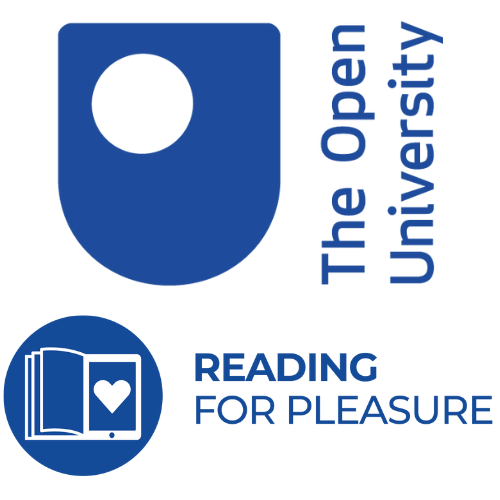Developing a Culture of Reading for Pleasure 2: Children as Readers
21 August, 2023
 Debbie Thomas is a Lecturer in Reading for Pleasure at the Open University, working to develop RfP pedagogy and research in schools across the country. She has also been a Regional Associate for The Centre for Literacy in Primary Education and has previously worked as a local authority English advisor, a primary teacher, leader and inspector in a variety of different settings.
Debbie Thomas is a Lecturer in Reading for Pleasure at the Open University, working to develop RfP pedagogy and research in schools across the country. She has also been a Regional Associate for The Centre for Literacy in Primary Education and has previously worked as a local authority English advisor, a primary teacher, leader and inspector in a variety of different settings.
In the second of a series of four blogs that explore the key findings of the latest RfP research, Debbie highlights the importance of developing our knowledge of children’s reading practices.
Getting to know you … as a reader
In the first of this series of blogs I examined the importance of developing our knowledge of children’s literature – of becoming Teachers who Read and Readers who Teach – if we are to successfully embed a culture of Reading for Pleasure in our schools.
In this second blog, the focus moves to the children in our classrooms and the importance of getting to know each of our pupils as a reader.
Knowing our children as readers involves much more than tracking their ability to decode or assessing their comprehension and inference skills. It is also important to consider factors such as their reading motivation, their reading preferences and their attitudes to reading. An initial snapshot in the form of a class reading survey at the beginning of the year (or as part of Transition) can be a useful starting point as we set out on this journey of discovery.
An ongoing process
And it is a journey for, while it is helpful to capture a child’s reading practices at a given point in time, getting to know them as a reader is an ongoing process – the ultimate AfL for reading – and we need to become aware of their developing reader identity by:
- Noticing and listening to their daily reading reality: what are they reading or not reading, where, when, with whom?
- Understanding their wider reading outside school: are they supported at home, do they have access to books and other texts, what are the attitudes and role models for reading?
- Accessing their reading histories: how have they become the reader (or disengaged reader) they are today?
- Tapping into insights from other members of the reading community: teaching assistants, volunteers, reading mentors and parents can all help us learn about our readers.
How do we gather this information?
There are a number of strategies and activities that teachers can use alongside a reading survey to help build a more rounded picture of their pupils as readers:
- Reading rivers allow us to consider significant memories and moments in our reading past and help us to reflect on how we have come to be the readers we are today. Reading rivers can be used with individual readers, a whole class and even with families.
- One-to-one reading conferences, whether in the form of a structured session or a more informal chat, provide an opportunity to explore each child’s reading identity in more depth.
- ‘What Makes a Reader?’ tasks provide useful insights into children’s concepts of reading and what being a reader means to them. The tasks can be revisited to see how these ideas develop through the year.
- Graffiti walls are a fun, visual way to share what is being read as a class, a year group or a school and often provide a springboard for some great book talk!
For these tools to be effective, however, they need to be used judiciously and flexibly. A planned, structured activity can provide us with lots of useful information about a child’s reading practices, but informal and incidental opportunities to ‘chat’ about reading can be equally revealing. As always, observing, listening, noticing, using dialogue and reflecting to draw inferences are key skills to help us create an accurate picture. You can find out how teachers around the country have adapted and implemented these different strategies in their own settings by exploring the Examples of Practice on the OU RfP website.
Using our insights to promote Reading for Pleasure
Having gathered these insights, how does our new understanding of our pupils as readers help us to promote a culture of Reading for Pleasure?
Just as no two children are the same, so ‘no two readers are the same’ (Cliff Hodges, 2010:182). Our knowledge of each individual’s reading interests enables us to match a book to each child more effectively, providing them with reading experiences that will entice, engage and encourage them to move forward on their reading journey.
Young readers can be constrained by unspoken (and perhaps unintended) messages that reading must be from a book, or from a certain genre of book. This marginalises much reading that is done for pleasure. By understanding and acknowledging a child’s wider reading practices – the sport section of the Sunday papers, the magazine shared with friends, the instructions for a new video game – we validate those reading experiences and the child’s identity as a reader, promoting greater self-esteem and engagement.
Extending our definition of what counts as reading in the 21st Century also ensures we can provide a more diverse range of texts that can tap into existing reading interests. Comics, magazines, newspapers and high-quality non-fiction texts all have their part to play in promoting Reading for Pleasure.
Encouraging children to explore and share their reading preferences and practices with us provides the opportunity to foster a positive reading identity. Much has been written about children accessing texts that offer both ‘mirrors and windows’ (Simms Bishop, 1990) on the world, and the power of seeing yourself and others in the texts you read. By knowing our children as readers, we are better able to both reflect their realities and broaden their concepts of the world in our selection of texts.
A new Reader to Reader relationship
It is tempting to see developing our knowledge of children as readers as one of the easier aspects of RfP pedagogy to implement, requiring little more than a well-put-together reading survey at the start of term. In fact, I would argue that the opposite is true. Developing an understanding of pupils’ reading identities takes time and commitment. It also requires us to take a risk, for it results in a fundamental shift in our relationship with our pupils. Getting to know our children as readers requires us to consider and share our own reading practices. Acknowledging our pupils’ wider reading experiences leads to a move away from a teacher-selected canon of acceptable texts. In this more open, dialogic environment, the traditional Teacher to Pupil power dynamic is transformed into a new Reader to Reader relationship that celebrates each individual reader identity.
For those who embark on this journey, the rewards are well worth the investment. Getting to know our children as readers enables us to foster the agency and desire to read and sits at the very heart of a Reading for Pleasure culture.
Further opportunities
Interested in learning more about the latest RfP research? The new Reading Teachers: Nurturing Reading for Pleasure book combines the latest academic insights with practical case studies. Or join us at one of our OU Reading for Pleasure conferences for a day of engaging talks and evidence-based workshops led by expert practitioners. Details of the next conference in March will be released soon. See you there!
First published in September 2022. Reviewed and updated August 2023.

